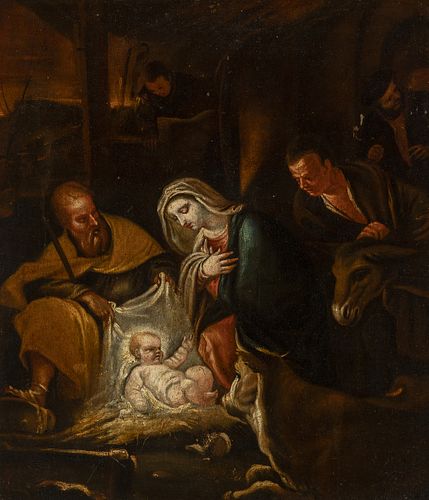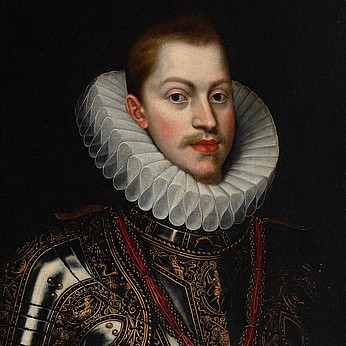Madrid School, Circle of FRANCISCO RIZI (Madrid, 1614-San Lorenzo de El Escorial, 1685); second half of the seventeenth century. "Adoration of the sh
Lot 31
About Seller
Setdart Auction House
Carrer Aragó 346
Barcelona
Spain
Setdart Subastas was born in 2004 and is currently the first online art auction in Spain with solidity, prestige and reliability guaranteed by our more than 60,000 users. Setdart has a young, dynamic and enterprising team ready to successfully manage the purchase and sale of art works through custom...Read more
Estimate:
EUR€3,000 - EUR€4,000
$3,125 - $4,166.67
Absentee vs Live bid
Two ways to bid:
- Leave a max absentee bid and the platform will bid on your behalf up to your maximum bid during the live auction.
- Bid live during the auction and your bids will be submitted real-time to the auctioneer.
Bid Increments
| Price | Bid Increment |
|---|---|
| EUR€0 | EUR€10 |
| EUR€200 | EUR€25 |
| EUR€500 | EUR€50 |
| EUR€1,000 | EUR€100 |
| EUR€3,000 | EUR€200 |
| EUR€5,000 | EUR€500 |
| EUR€10,000 | EUR€1,000 |
| EUR€20,000 | EUR€2,000 |
| EUR€50,000 | EUR€5,000 |
About Auction
By Setdart Auction House
Nov 24, 2021
Set Reminder
2021-11-24 09:00:00
2021-11-24 09:00:00
America/New_York
Bidsquare
Bidsquare : Old Masters, Day 1
https://www.bidsquare.com/auctions/setdart-auction-house/old-masters-day-1-7873
Setdart Auction House sofia@setdart.com
Setdart Auction House sofia@setdart.com
- Lot Description
Madrid School, Circle of FRANCISCO RIZI (Madrid, 1614-San Lorenzo de El Escorial, 1685); second half of the seventeenth century. "Adoration of the shepherds". Oil on canvas. Relined. Presents repainting. It has a frame of the eighteenth century. Measurements: 62 x 55 cm; 72 x 63,5 cm (frame). The painting represents the moment in which the shepherds are adoring the Child Jesus. Arranged in an interior of dark tonalities, the author has placed all the characters of the scene making use of a classic composition as a frieze. Slightly displaced to the left, and in the lower area, the figure of the child can be seen on a bed of straw. He is being uncovered by St. Joseph, who holds the white cloth to facilitate the adoration of the shepherds. In the center Mary puts her hand on her breast and tilts her head down with her eyelids closed, adopting an attitude of sorrow as if she knew the fate of her little baby. To the right of the virgin, a shepherd leans on the mule to better observe the scene, behind him another shepherd turns his face towards an exterior point as if appealing to someone who is not in the scene, inviting him to participate in the scene. Finally, in the last shot, a sketched figure contemplates the scene. Due to its technical characteristics, the work is aesthetically identified with the school of Francesco Rizi, son of the painter Antonio Rizi. Despite his Italian origin, Francisco was born in Madrid, as his family had moved to Spain to work in El Escorial. Francisco began his training with his father, along with his brother Juan, but later continued studying with Vicente Carducho, from whom he received a great artistic influence. In 1634, he obtained contact with the Royal Audience, which was supposed to establish him as a painter. When Carducho died in 1638, he joined other painters to finish the decoration of the Golden Hall of the Alcazar of Madrid. He is known for being one of the first Spanish painters to be influenced by the Baroque style, with direct influences from the paintings of artists such as Rubens and Van Dyck. Thanks to his work, he attracted the attention of the court, so he began to work for them, carrying out numerous commissions. In addition, thanks to his collaboration with the cathedral of Toledo, he managed to become the official painter of the cathedral, a position he retained until the day of his death. In 656 he was appointed Painter to the King, thus becoming one of the most sought after artists of the time, which allowed him to open a workshop, where renowned artists such as Claudio Coello were trained. Due to his well-to-do situation in the court, he was granted permission to live in the Real Alcázar. However, in 1671, when Juan Carreño was appointed painter to Queen Mariana, his position in the court declined, although he continued to be appreciated by religious institutions.
- Shipping Info
-
In-house shipping available. Please inquire at admin@setdart.com.
-
- Buyer's Premium



 EUR
EUR CAD
CAD AUD
AUD GBP
GBP MXN
MXN HKD
HKD CNY
CNY MYR
MYR SEK
SEK SGD
SGD CHF
CHF THB
THB

















